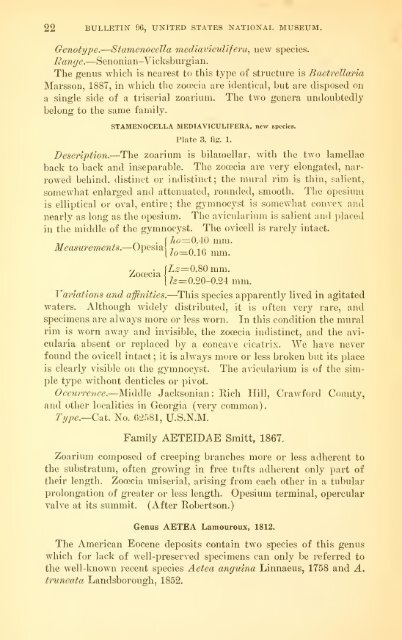Bulletin - United States National Museum - Smithsonian Institution
Bulletin - United States National Museum - Smithsonian Institution
Bulletin - United States National Museum - Smithsonian Institution
Create successful ePaper yourself
Turn your PDF publications into a flip-book with our unique Google optimized e-Paper software.
22 BULLETIN 9G, UNITED STATES NATIONAL MUSEUM.<br />
Genotype.—Stamenocella mediaviculifera^ new species.<br />
Range.—Senonian-Viclcsbiirgiun.<br />
The genus which is nearest to this type of structure is Bactrellaria<br />
Marsson, 1887, in which the zooecia are identical, but are disposed on<br />
a single side of a triserial zoarium. The two genera undoubtedly<br />
belong to the same family.<br />
STAMENOCELLA MEDIAVICULIFERA, new species.<br />
Plate 3, fig. 1.<br />
Description.—The zoarium is bilamellar, Avith the two lamellae<br />
back to back and inseparable. The zoa3cia are very elongated, narrowed<br />
behind, distinct or indistinct; the mural rim is thin, salient,<br />
somewhat enlarged and attenuated, rounded, smooth. The opesium<br />
is elliptical or oval, entire; the gymnocyst is somewhat convex and<br />
nearly as long as the opesium. The avicularium is salient and ])laced<br />
in the middle of the gymnocyst. The ovicell is rarely intact.<br />
Measurements.—Opesia<br />
Zocecia<br />
A6>=0.40 nun.<br />
Zo=0.1G mm.<br />
fZs=0.80 mm.<br />
Zs=: 0.20-0.24 mm.<br />
Variations and affinities.—This species apparently lived in agitated<br />
waters. Although widely distributed, it is often very rare, and<br />
specimens are always more or less worn. In this condition the mural<br />
rim is worn away and invisible, the zooecia indistinct, and the avi-<br />
cularia absent or replaced by a concave cicatrix. We have never<br />
found the ovicell intact ; it is always more or less broken but its place<br />
is clearly visible on the gymnocyst. The avicularium is of the sim-<br />
13le type without denticles or pivot.<br />
Occurrence.—Middle Jacksonian: Rich Hill, Crawford County,<br />
and other localities in Georgia (very common).<br />
Type.—Q^'^i. No. G2581, U.S.N.M.<br />
Family AETEIDAE Smitt, 1867..<br />
Zoarium composed of creeping branches more or less adherent to<br />
the substratum, often growing in free tufts adherent only part of<br />
their length. Zooecia uniserial, arising from each other in a tubular<br />
prolongation of greater or less length. Opesium terminal, opercular<br />
valve at its summit. (After Robertson.)<br />
Genus AETEA Lamouroux, 1812.<br />
The American Eocene deposits contain two species of this genus<br />
which for lack of well-preserved specimens can only be referred to<br />
the well-known recent species Aetea anguina Linnaeus, 1758 and A.<br />
truncata Landsborough, 1852.

















